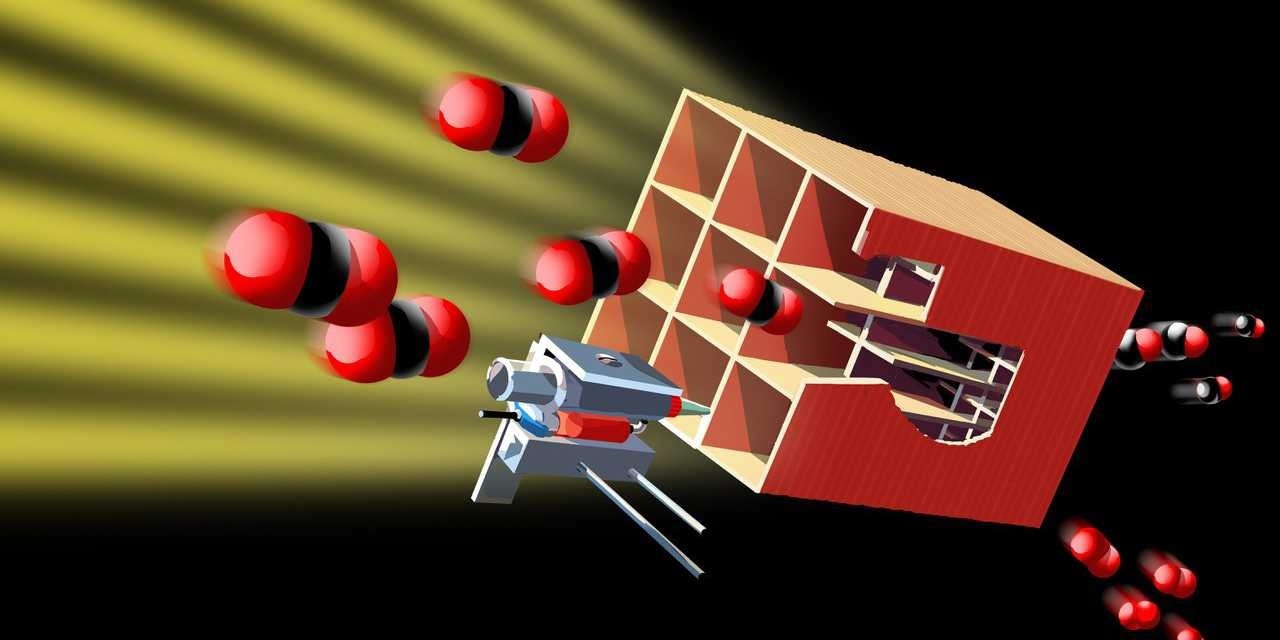ETH Zurich researchers created customized ceramic structures for a solar reactor using a new 3D printing process. Initial experiments demonstrate that these structures can increase the yield of solar fuels.
 The artwork illustrates a 3D-printed ceria structure with hierarchically channeled architecture. Concentrated solar radiation is incident on the graded structure and drives the solar splitting of CO2 into separate flows of CO and O2. Image Credit: Advanced Materials Interfaces, Vol 10, Nr. 30, 2023. https://doi.org/10.1002/admi.202300452
The artwork illustrates a 3D-printed ceria structure with hierarchically channeled architecture. Concentrated solar radiation is incident on the graded structure and drives the solar splitting of CO2 into separate flows of CO and O2. Image Credit: Advanced Materials Interfaces, Vol 10, Nr. 30, 2023. https://doi.org/10.1002/admi.202300452
Engineers at ETH Zurich have developed technologies to manufacture liquid fuels from sunlight and air in recent years. In 2019, they showed the whole thermochemical production chain under real-world conditions for the first time on the roof of the ETH Machine Laboratory in Zurich.
These synthetic solar fuels are carbon neutral since they emit only the amount of CO2 extracted from the air during their production. Climeworks and Synhelion, two ETH spin-offs, are further developing and commercializing the technologies.
A solar reactor, exposed to concentrated sunlight provided by a parabolic mirror and reaching temperatures up to 1500 °C, lies at the heart of the manufacturing process. A thermochemical cycle for dividing water and CO2 obtained from the air takes place inside this reactor, which has a porous ceramic framework built of cerium oxide.
The product is syngas, a mixture of hydrogen and carbon monoxide that can be converted into liquid hydrocarbon fuels like kerosene (jet fuel) for use in aviation.
Structures with isotropic porosity have previously been used, but they have the disadvantage of exponentially attenuating incident solar radiation as it passes into the reactor. As a result, the inner temperatures drop, limiting the solar reactor's fuel production.
Researchers from André Studart’s (ETH Professor of Complex Materials) and Aldo Steinfeld's (ETH Professor of Renewable Energy Carriers) groups have developed a novel 3D printing methodology that allows them to create porous ceramic structures with complex pore geometries to transport solar radiation efficiently into the reactor’s interior. The Swiss Federal Office of Energy is funding the research effort.
Particularly effective designs are hierarchically arranged ones with open channels and pores that narrow toward the reactor’s rear and remain open at the surface when exposed to sunlight. With this configuration, the full volume can absorb the incident-concentrated solar radiation. Consequently, this guarantees that the entire porous structure reaches the reaction temperature of 1500 °C, increasing fuel production.
An extrusion-based 3D printing method and a newly created ink type with ideal properties—namely, low viscosity and a high concentration of ceria particles to maximize the amount of redox active material—were used to create these ceramic structures.
Successful Initial Testing
The intricate relationship between radiant heat transport and the thermochemical process was examined by the researchers. They demonstrated that when exposed to the same concentrated solar radiation with an intensity equal to 1000 suns, their new hierarchical structures can produce twice as much fuel as the uniform structures.
Synhelion has obtained a license from ETH Zurich to use the patented technique for 3D printing ceramic structures.
This technology has the potential to boost the solar reactor’s energy efficiency and thus to significantly improve the economic viability of sustainable aviation fuels.
Aldo Steinfeld, Professor, Renewable Energy Carriers, ETH Zurich
Journal Reference:
Brunser, S. S., et al. (2023) Solar-Driven Redox Splitting of CO2 Using 3D-Printed Hierarchically Channeled Ceria Structures. Advanced Materials Interfaces. doi:10.1002/admi.202300452